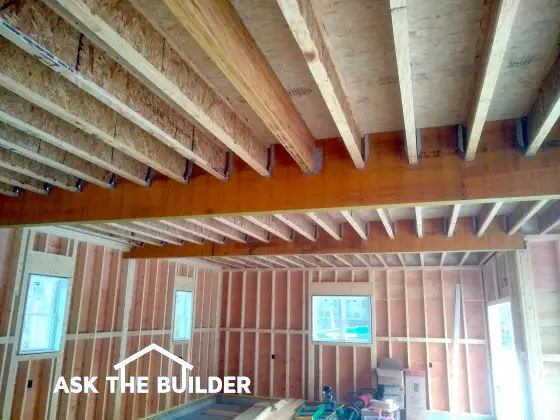Engineered I Joist Advantages

I remember the first time I saw engineered I joists used in a job here in Cincinnati. I would be willing to bet $500 that it was in the late 1970's. They were the floor joist components of a mini-condominium project. One of the condo units was half finished and the owner had abandoned the project. I was considering purchasing the condo to finish it out for resale. I didn't buy the condo - the reason had nothing to do with the floor joists although I must admit I had my reservations about the seemingly undersized structural material!
Think Steel
The next time you pass buy a commercial building under construction or you can view a traditional I beam up close, I want you to really look at the way one of those is made. Look at how thin the steel web or center portion of the beam actually is. Often they are just slightly thicker than 1/4 inch! I then want you to imagine how much weight one of these single beams can carry. Note that the beams don't have to be 1.5 inches thick - the thickness of a standard floor joist - to do the job.
It should come as no surprise that wood I beams can copy the same format as steel I beams and do so with predictable, consistent strength results. This is exactly how engineered wood I joists were born.
Different Depths
The stiffness or load bearing capacity of a beam (steel or wood) is a function of the distance the beam spans, the type of material it is made from, and the depth or height of the beam. You can demonstrate this very easily.
Imagine framing a floor using 2x4's as floor joists. If you made those span a typical 13 foot space, I don't know if I would walk across the floor. If it didn't collapse under my weight, it would most certainly sag! Now, substitute 2x12 joists in the same system. You and I both know that the floor system will be as strong as can be and 30 people standing on the floor probably would make little difference. The strength of the floor system increased at a faster rate than the depth of the joist material. In other words, the difference in depth of the joists increased by about 3.5 times, but the strength of the system increased possibly by a factor of 20 or more. All of this simply because we increased the depth of the joist or beam!
The new engineered floor joists can be purchased in a variety of depths that range from 10 inches to 16 inches. Each depth can be purchased with different top and bottom flanges as well. All of these things factor into the allowable distances you can span with each type of joist.
If you want a stiff floor, you simply go with a deeper floor joist or shorten the span of the floor joist. All of these considerations should be done by a structural engineer who designs floor systems. Don't even think about trying to guess what size you need!
Programs Also
The engineers who design I joist floor systems use very sophisticated computer programs that were developed by the floor joist manufacturers. The engineers simply have to enter in certain data about the size of the house and the anticipated floor loads and BINGO! out comes the recommended floor joist size. Don't even bother about asking to get this software. It is only available to engineers and lumber company professionals who are trained how to use it. Floor design is NOT a DIY project.
I-Joist Advantages
The APA PRI-400 standard makes engineered wood I joists easy to specify and order.
I joists install much in the same manner as traditional wood floor joists. There are several things you must do to insure a fault free installation, however this can usually be learned in several hours. No single detail is very complicated. All of these details are illustrated exceptionally well in a FREE booklet that is offered by the APA. Visit the Engineered Wood Association's web site at www.apawood.org and check under publications for information that can be downloaded.
I joists are available in deeper depths than standard floor joists. The largest standard floor joist is a 2x12. You can order I joists in depths up to 16 inches! This allows you to span greater distances which normally translates to wide open spaces.
I joists are also more consistent in size and shape than traditional floor joists. Some new flooring materials (laminate flooring) can't be installed over traditional floor joists that have different height crowns. You don't have this problem with I joists! They are true and straight all of the time.
I joist span design standards make them a stiffer floor. This can help reduce squeaks. It also makes a more solid floor. I joists are superb. Give them a serious look!
Column B227
One Response to Engineered I Joist Advantages